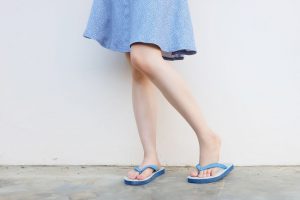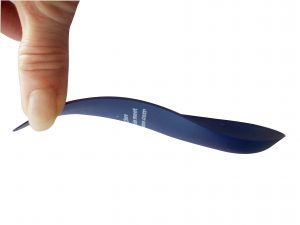
Indianapolis Star Let It Out
During summer you’ve probably noticed that flip flops seem to be the only type of shoe people wear, especially young people. Sure, flip flops come in assorted colors, so you can wear them with everything. And their low price means you can afford to own a closet full of them. But – as this Indianapolis Star “Let It Out” piece points out, if you’re wearing 99-cent flip flops, you’ve got to expect your feet to hurt. While the younger generations may think “decent shoes” aren’t very cool, they are the wiser choice of footwear. We’ll explain why in this blog post.
The Origins of Flip Flops
You might be surprised to learn that flip flops are one of the oldest types of shoes. They date back to ancient Egypt, around 4000 B.C. They also were worn by the Mesopotamians and Romans.
Our modern flip flops come to us from Japan. During World War II, Japan was big into rubber production. Following the war, they exported flip flops (marketed as Zoris) to the U.S. American housewives used them when taking a shower. Eventually, children began wearing them as a summer footwear staple. In the late 1990s, flip flops became even more popular when splashy, sparkly Brazilian Havaianas hit the market.
However, flip flops were never really intended for day-in, day-out wear. They were made for walking at the pool, on the beach, or on warm surfaces when schlepping your gear to the pool or beach. Flip flops were meant to protect your feet from sharp objects and burns. Additionally, they were intended for wear in public showers to prevent people from contracting athlete’s foot, plantar warts, and other fungal infections.
Flip flops were never meant to be worn all day.
Why You Shouldn’t Make Flip Flops Your Go-to Shoe Choice

Photo credit: 123RF / yayha
Simply put, flip flops are detrimental to your health. Unlike sturdy shoes, the thin, flimsy soles of flip flops weren’t made for extensive walking. They offer no arch support, heel cushioning, or shock absorption. Therefore, your feet take the full force impact when walking. Combined with the fact that your feet have more nerve endings per square inch than any other part of your body, it’s little wonder why you have foot pain when wearing flip flops.
Lack of foot support when wearing flip flops can lead to arch pain, heel pain, and tendinitis. Also, since you must grip the flip flops with your toes to keep them on, you can experience calf and knee strain as well as spinal stress over time.
Normally, when wearing sturdy shoes, you walk with a heel-toe stride. However, researchers have found that flip flops can change your stride since they don’t provide any arch, heel, or side foot support. You’ll likely walk with shorter steps to keep them on your feet. You may even start dragging your feet and not fully hitting the ground with your heels as you walk. These movements can change your posture and throw you off balance. You’ll likely experience more muscle and joint pain in your ankles, knees, hips, and back.
Additionally, the lack of support to your feet may cause them to twist or turn, which can lead to sprains, fractures, and falls.
All things considered; your easy, breezy summer footwear may not be so fun after all.
Foot Problems Caused by Flip Flop Wear
Additionally, non-supportive footwear like flip flops can cause other foot problems like:
Athlete’s Foot and Other Fungal Infections
Even though flip flops are better than nothing when walking at pools and in public showers, the lack of proper foot covering still exposes you to these potential infections. Plus, the foam soles can be a breeding ground for bacteria, especially in moist, hot conditions.
Blisters
The strap between your toes can rub causing sore spots or blisters to form.
Corns and Calluses
After constant walking in flip flops, over time, you can develop uncomfortable corns or calluses on the soles of your feet.
Hammertoes
To keep your flip flops on, you may curl your toes down as your walking. If you continue to scrunch your toes, eventually, you may not be able to straighten your toes out, causing hammertoes.

Photo credit: iStock / paisan191
Heel Fissures
Also known as cracked heels, fissures can form on your heels due to the pressure of your feet against the thin soles of the flip flops. Additionally, the summer heat can cause the skin to dry out and become cracked.
Heel Pain and Heel Spurs
Since flip flops don’t provide support for your feet, you may eventually experience heel pain. In fact, heel pain is becoming a common issue seen in 15- to 25-year-olds who wear flip flops every day to school. If you also experience bouts of plantar fasciitis, calcium may buildup on your heel, causing a spur to form. Heel spurs are caused by the stretching of the plantar fascia and the repeated tearing of the membrane covering your heel bone.
Metatarsalgia
Normally, you walk from heel to toe when wearing closed shoes with arch support. However, flip flops don’t provide arch support, so your foot flattens out as you walk. Over time, the ball of your foot can become irritated, especially if you’re curling your toes as you walk. This combination of inflammation and swelling is called metatarsalgia.
Plantar Fasciitis
The plantar fascia is a fibrous tissue that runs along the bottom of your foot, connecting your heel bone to your toes. Flat, flimsy flip flops don’t provide enough support for the plantar fascia. Eventually, the plantar fascia can become inflamed and cause intense heel pain known as plantar fasciitis.
Sprains, Strains, and Stress Fractures
Without the necessary support your feet need, you’re more apt to twist or roll your ankle when wearing flip flops. Twisting or rolling your ankle can cause strains and sprains. Also, a bad twist may cause a stress fracture.
Tendinitis
When you wear flip flops, the tendons and connective muscles in your feet must work harder to keep your footwear on your feet. Eventually, you’ll experience inflammation in your tendons and muscles. This painful condition is known as tendinitis. If it is left untreated, it can lead to muscle tears and additional pain in your feet.
Why Proper Shoes Are Better for Your Feet
If you don’t want to experience any of the painful foot conditions above, wearing proper shoes just makes more sense. Wearing sturdy shoes doesn’t mean you have to wear shoes that wholly enclose your entire feet. You still can wear sandals. Just make sure your sandals are constructed well with better materials, like any of these recommended by the WalkEZStore.
Generally, robust shoes also have a thicker sole, unlike flimsy foam flip flops, to protect your feet. Likewise, they offer more traction to prevent ankle rolls or falls.
Additionally, well-made shoes often provide some arch support to absorb your impact while walking. Plus, they typically have more interior padding for greater comfort.
Furthermore, you may want to choose sturdier sandals with a back strap or multiple straps. Straps can help keep your feet in place within your shoes. Also, they help take the pressure off your toes since they don’t have to grab onto to shoes when walking to keep them on.
No matter what type of shoes you buy, always make sure they fit well. Check out the WalkEZStore’s Shoe Fitting Guide for more tips on proper shoe fit.
Your Feet Don’t Have to Hurt

ezWalker Custom Fit Orthotic
Hopefully, now you know why you shouldn’t wear 99 cent flip flops. And why you should wear sturdier footwear. After all, who wants to live with feet or knees or a back that hurt?
However, if you still suffer from pain due to a foot ailment, you may want to invest in a pair of ezWalker® Custom Fit Orthotics. Our custom orthotics are created by Kathy Carandang, a certified pedorthist, who understands the bone and muscle structure of your feet. She knows how abnormalities in the way you walk can affect your whole body and result in pain.
ezWalker® Custom Fit Orthotics are bio-mechanically constructed to the exact specifications of your individual feet. They support your arches and help guide your feet into proper alignment.
The great news is ezWalker® Custom Orthotics are thin and ¾ length, so they fit in most footwear. That includes sandals – with the help of a piece of Velcro® to secure them in place!
If you’re ready to get rid of your foot pain, schedule an appointment with the WalkEZStore today. Or, you can order our orthotics kit online and create your foot molds in the comfort of your own home. Once you return your kit to the WalkEZStore, we’ll create your custom orthotics and send them back to you.
WalkEZStore Believes Decent Shoes Are a Cool Option!
Remember, take care of your feet with supportive, decent footwear. Because people who don’t care about their feet and use flip flops as their shoes of choice, unfortunately, will deserve what they get – namely pain! Decent shoes are your wiser (and cooler) choice if you truly care about your overall health and wellness – which all starts with your feet.
Because … when your feet aren’t happy, the rest of your body will let you know.
Disclaimer: The information included in this article is for educational purposes only. It should not be used as a substitute for professional medical advice, diagnosis or treatment.


